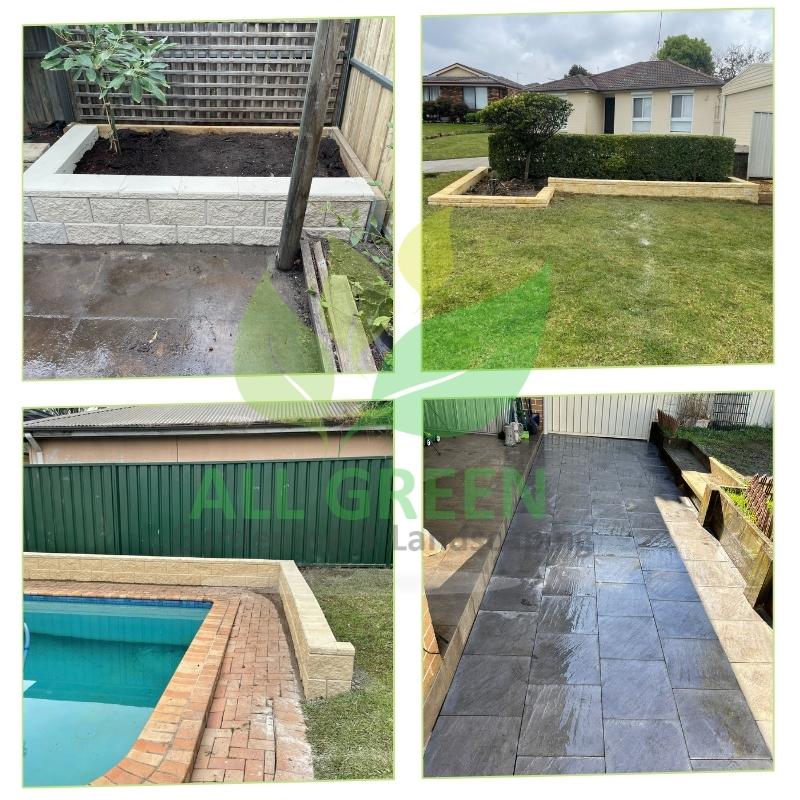Quick and Hassle-Free Landscaping Claremont Meadows Services. Moreover, time is of the essence. Realise your dream yard without unnecessary delays with All Green Gardening Services. In short, we deliver fast and reliable landscaping solutions. Promptly call us and start your project today.

Looking for a Local Landscaper in Claremont Meadows? 🌱
To discover a local landscaper, “landscaper near me” is the typical search term used. Here’s who we are! We cater to landscape garden maintenance needs, from retaining walls to outdoor space and garden design, and complete landscaping projects.
Claremont Meadows’s Best Landscaping Company Is Here
For both extensive and minor projects, our landscape design services are cost-effective and top-notch. For structural landscaping, our expert team delivers a total solution.
With our Best Price Guarantee, we provide local affordability and expertise!
Elevate your NSW property with All Green Gardening & Landscaping’s mastery. We’re adept in paving, mulching, and everything in between. With us, gardens bloom and property values rise. Envision a garden of dreams and let us manifest it. Contact today.
We also serve and have landscaping projects in the following surrounding suburbs:
All Green Gardening & Landscaping’s Edge:
- Diverse Expertise: No garden task is beyond our scope.
- Property Amplification: See your property glow and its value rise.
- Specially for You: Tailored solutions that match every garden’s essence.
- Eco Devotion: Green practices are integral to our work ethic.
- Peak Professionals: Our seasoned landscapers bring excellence to the table.
- Customer Delight: Timely and top-tier service to ensure client happiness.
Claremont Meadows Landscaping Services by All Green Gardening & Landscaping
We’re known at All Green Gardening and Landscaping for our ability to fashion exceptional, eco-friendly surroundings that elevate any home or business with our expert landscape design. Keep in the loop by following our Facebook Page. Whether it’s small-scale backyard landscaping in Claremont Meadows or a more extensive project, our focus remains on delivering top-notch customer service and professional landscaping solutions in Claremont Meadows. In the realm of landscaping, we excel in both residential and commercial sectors, teaming up with our experienced designers and installers.
Our licensed landscape designers will ensure the best design for your substantial projects. We’ll schedule a site consultation with our designers to delve into your project and determine the necessary tasks. After this, we’ll deliver a comprehensive landscape design consultation for you.
Why Trust All Green Gardening & Landscaping? ⭐
Serving your community since 2010, we’re the go-to for superior Claremont Meadows landscaping. 100% Satisfaction Guaranteed with gardening and landscaping services provided by us.
For the Best Landscaper Nearby, our name is synonymous with the exceptional services offered by our experienced landscapers.
Our Services
Best Turf Laying Solutions in Claremont Meadows
Why Choose All Green Gardening for Turf Laying Services in Claremont Meadows. Undeniably, experience matters. With years of expertise in turf laying, All Green Gardening Services is the trusted name for many. Our professionalism speaks volumes. Simply put, you’re in good hands with us. Contact us and experience excellence. Year-Round Maintenance with Turf Laying Services in Claremont Meadows. Lastly, a perfect lawn needs regular upkeep. Alongside turf laying, All Green Gardening Services offers maintenance to keep your lawn green all year. To conclude, a well-maintained lawn is not a dream but a reality—just a call away.
Top-Quality Mulching Services: Best in Claremont Meadows, NSW
For gardens that resonate with health and beauty, trust All Green Gardening & Landscaping’s mulching services. Operating inClaremont Meadows, NSW 2747, we provide mulching that enriches soil, curbs weeds, and beautifies spaces. Join hands with us for landscaping that truly stands out.
Our Paving Claremont Meadows Experts
In Claremont Meadows, if you desire top-quality pavers, All Green Gardening and Landscaping is the answer!
Need a Retaining Walls Claremont Meadows Team
We take pride in supplying Claremont Meadows clients with high-quality panel and post concrete retaining walls, a wallet-friendly alternative to brick and limestone.
Expert Tree Services inClaremont Meadows
Engage with the best in tree services at All Green Gardening & Landscaping. Catering toClaremont Meadows, our range of services ensures optimal tree health and safety. Lean on our expertise for outstanding tree management.
Top-Tier Weeding Services in Claremont Meadows
Keep your garden flourishing with All Green Gardening & Landscaping’s exceptional weeding services. Serving Claremont Meadows, our experts remove and prevent unwanted growth, ensuring your plants remain undisturbed. Choose us for gardens that radiate health and beauty.
Affordable Landscaping Services in Claremont Meadows NSW 2747
Frequently Asked Questions
{We offer a comprehensive range of landscaping services, including garden design, lawn maintenance, tree and shrub care, hardscape construction, irrigation system installation, and more. | Explore our wide range of landscaping services, spanning garden design, lawn care, tree and shrub maintenance, hardscape construction, irrigation system installation, and more.
We work to enrich your property’s aesthetics with landscaping services, forming enchanting outdoor spaces that increase curb appeal and property valuation.
We excel in delivering bespoke landscaping solutions, making your outdoor area a reflection of your unique style.
Current Landscaping Jobs in Claremont Meadows
Calling all experienced Local Landscapers in Claremont Meadows! Same-day jobs await – apply through email.
[justified_image_grid row_height=800 height_deviation=0 overlay=off use_timthumb=no disable_cropping=yes flickr_search_text=Claremont Meadows-NSW max_rows=4 flickr_search_sort=popular]

